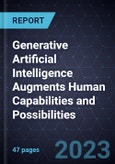Based on public data-trained models, Gen AI algorithms can generate new and creative information/data like the original content produced by humans. This phenomenon has created a massive buzz in the market, transforming how we search for information, create content, and conduct business.A Journey into the World of Artificial Generation and Synthetic Creation
The latest developments in large language models and their consequent impact on generative AI-based solutions can potentially transform a range of sectors, workflows, and tasks like never before. As a growing ecosystem around technology takes shape, funding and innovation also grow exponentially. In the future, multiple industries and key nodes will likely witness profound changes ushered in by generative AI and allied opportunities.
Open AI began the revolution with its well-known product, ChatGPT. Hundreds of start-ups have emerged to create new GenAI models that not only create text or images but also conduct R&D and create many new things, such as music, software, pharma products, and enterprise solutions.
Companies face significant challenges in creating such models and must ensure compliance with each sector’s standards and regulatory needs. A need exists to analyze and develop methods to safeguard content from cyberattacks and fraudulent activities.
This study assesses the emerging GenAI scenario and opportunities that the technology offers and looks at the following topics:
- GenAI and its models
- Factors influencing adoption: Growth drivers and challenges
- Current and emerging applications
- Patent and funding trends
- Technology development landscape
- Major innovations and innovators
- Technology strategies of major industry participants
- Roadmap and emerging opportunities
Table of Contents
Companies Mentioned (Partial List)
A selection of companies mentioned in this report includes, but is not limited to:
- Microsoft








